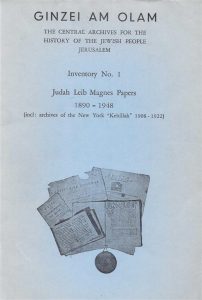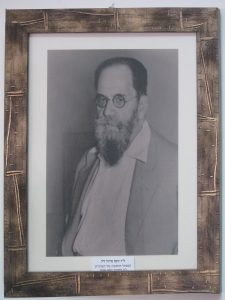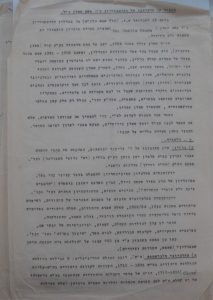
The Central Archives for the History of the Jewish People (CAHJP; הארכיון המרכזי לתולדות העם היהודי) is a leading repository of Jewish historical materials from all over the world from the 16th century to the present. Initially founded in 1939 by Josef Meisl as the JHGA (JHGA; הארכיון הכללי לתולדות ישראל), it opened to the public in February 1947. The group adopted its current name in 1969; today, it is located adjacent to Hebrew University’s Givat Ram campus. In 2015, the CAHJP was incorporated into the National Library of Israel and will relocate to the new building when it is completed.
The CAHJP holds over 6 linear kilometers of archival files, ranging from historic charters and privilegia to communal record books (pinkasim) and modern-day records of institutions and prominent figures. These materials originate from nearly 60 countries in Europe, North and South America, the Middle East and North Africa, and South Asia, and are found in about 70 languages. They also hold over 300 private collections.
The developing mission of the JHGA/CAHJP was to document Jewish history throughout the world in support of the development of Jewish historical research in Israel. Under the banner of the “ingathering of the exiles of the past,” they worked to gather archive collections both in the original and duplicate, and sent scholars and archivists abroad to survey archives, create catalogues and indexes of materials related to Jewish history in “general archives” (i.e. state and public archives not specifically dedicated to Jewish history) as well as to assist Jewish communities in preserving their records, often with the hope that they would eventually be transferred to Jerusalem. These three categories—originals, microfilms, and surveys—still make up the three main forms of materials held in the CAHJP.

The Central Archives for the History of the Jewish People was originally founded in 1939 as the Jewish Historical General Archives (JHGA), under the leadership of Josef Meisl, the former librarian of the Berlin Jewish community. The first materials in the collection were the personal research files of the German-Jewish historian Moritz Stern (1869-1939). Stern had sent his files to Palestine in 1938 prior to his planned immigration to Palestine, but after he passed away, his son Josef offered the files to Meisl who used them as the basis for the archive. In 1944, the JHGA was incorporated into the Palestine Historical and Ethnographic Society (since 1951 the Historical Society of Israel), and in 1947 the archive opened to the public on Mt. Scopus in eastern Jerusalem (prior to this the files had just been in Meisl’s apartment). After the 1947-49 war, when Mt. Scopus was cut off from the rest of Jerusalem, the archive relocated to an apartment in the center of the city, not far from the cease-fire line; and later at Yad Vashem.

The JHGA focused much of its early collecting efforts on Europe, and especially Germany, for two main reasons. First of all, most of the JHGA’s leaders were themselves of German origin, which both meant they had personal interest in these materials and also had personal connections that could assist in the process; for instance, Alex Bein had begun his archival career at the German Reichsarchiv in Potsdam, where he worked from 1927 until he was sacked in 1933, and some of the leading postwar German archivists were his former colleagues. Secondly, the postwar restitution process made archives in Germany easily accessible to the Israelis. As a result, they were able to gain the files of nearly 800 Jewish communities by the 1960, including the former files of the Gesamtarchiv and the historic archives of the Jews of Worms, Hamburg-Altona-Wandsbeck, and Vienna. As a result, by 1961, when the Hamburg files arrived in Jerusalem, Daniel Cohen—himself born in Hamburg and by then the archive’s director—declared that the “ingathering of the exiles of the past” had been concluded, “as far as West Germany is concerned.”
However, the Jerusalem archives were never exclusively interested in Germany: Over the following decades, they sought materials from eastern Europe, especially following the end of the Cold War, as well as around the world in the interest of their “Central Archives for the History of the Jewish People,” a name they took upon themselves in 1969. As Cohen explained at a genealogical conference in Salt Lake City in 1969, they saw themselves as creating a central research center for all of Jewish history, where researchers could come to one place and study all aspects of Jewish history. As he put it then, “we see in these documents first of all the legacy of the Jewish nation and it is from this point of view—the conception of the unity of Jewish history—that we look upon them as building-stones for the greater edifice of our history through the ages.”
The CAHJP was clearly formed as part of the broader Jewish nationalist project in Israel/Palestine, an effort to support Jewish historical scholarship in Jerusalem and to supplement the vision of an “ingathering of the exiles” or kibbuts galuyot, the mass migration of Jewish people to the newly-founded state, with the “ingathering of the exiles of the past,” bringing the files of Jewish communities to Jerusalem. Indeed, the process of gathering archives was part of a process of helping to display the “Jewish” character of the newly founded Jewish state through holding the materials of the Jewish past and thus indicating its position as a successor to European Jewry.
However, the CAHJP’s claims to the materials they acquired has always been complicated. Firstly, they could not gain Nazi-looted archives directly. Instead, they were provided them by the Jewish Restitution Successor Organization (JRSO) and other restitution groups in the American, French, and British zones of occupation in Germany. Secondly, over the decades there have been a number of tensions over who should have these files. Even in the 1950s, as detailed in A Time to Gather, it took years of court battles and tense negotiations to bring the files of Worms and Hamburg to Jerusalem, because some local figures in Germany (both Jews and non-Jews) argued strenuously that these materials should remain close to their points of origin—in the view of archivists like Worms’ Friedrich Illert, the Jews would eventually return and he should hold the files for a future Jewish community in trust, and municipal and archival leaders in Hamburg contended that the files had not really been “looted” in the first place. More recently, the Jews of Vienna tried to reacquire their historical archives, which they provided willingly to the Jerusalem archives in the 1950s and 1960s, after they discovered another cache of files. Ultimately, Israel’s supreme court ruled that these files could not be returned in the original because they constituted Israel’s “national cultural patrimony,” leading to an agreement to scan the archives.
Undeniably, the CAHJP is one of the most important research centers for the study of Jewish history, given that they have brought together records and archives from so many places. Indeed, the CAHJP together with other archives in Israel has made it impossible to seriously study Jewish history in the Diaspora without spending time in Israel. It also raises important questions about what it means to “own” the past, the ways that holding archives holds a powerful symbolism in addition to their practical utility for research.
Research Notes
The CAHJP is located in Jerusalem. It will relocate to the new National Library of Israel building, close to the Knesset, after construction is complete. For the time being, it is in a caravan in the “High tech park” adjacent to the Hebrew University’s Givat Ram campus and within walking distance from the National Library. It is accessible by car, and also by bus #69. Researchers should expect to pass through Hebrew University security on their way to the archives.
The CAHJP has detailed finding aids online in English, German, and Hebrew. They can be easily searched, as well as browsed by country. In addition, there are printed finding aids for collections kept in a cabinet in the reading room. These are usually older finding aids; sometimes these collections have newer finding aids available online, but the old ones have original notes from the archivists and scholars who collected the files.
The CAHJP’s extensive collections can be accessed in a well-lit reading room, as well as in other rooms which have microfilm readers. Researchers should be aware that it has limited seating. There is a single computer in the reading room which can be used to access the website and digitized finding aids. There is no public wi-fi in the reading room. (Potentially a benefit!)
The CAHJP allows scholars to photograph material.
Across the hall from the reading room is a detailed card index of the CAHJP’s holdings; it is unclear if the index is still updated, but it provides a useful way to examine the materials on the basis of topic and location.
Most, but not all, of the staff speaks English.
There are set times of the day when CAHJP staff will bring materials to the reading room, which are are requested by filling out a paper slip.
Some of the CAHJP’s materials are kept onsite in an adjacent trailer, which means that they can be brought to the reading room on the same day. However, other less-frequently consulted materials (e.g. the JRSO papers) are held offsite in a warehouse in the Talpiot neighborhood, across town. As a result, scholars should be prepared to wait a few days for files to arrive, and it is beneficial to group file requests based on where the materials are stored, to limit the number of trips across town for archival staff. While food is not allowed in the archive, it is well known that bringing chocolate (especially Toblerone) helps files arrive on time.
Further Reading
- Jason Lustig, A Time to Gather: Archives and the Control of Jewish Culture, chs. 2-4
- Jason Lustig. “Who Are to Be the Successors of European Jewry? The Restitution of German Jewish Communal and Cultural Property.” Journal of Contemporary History 52, no. 3 (2017): 519–45.
- Denise Rein. “Die Bestände Der Ehemaligen Jüdischen Gemeinden Deutschlands in Den ‘Central Archives for the History of the Jewish People’ in Jerusalem: Ein Überblick Über Das Schicksal Der Verscheidenen Gemeindearchive.” Der Archivar 55, no. 4 (2002): 318–27.
- Inka Arroyo. “Raison d’etre des ‘Central Archives for the History of the Jewish People’ als virtuelle ‘Staatsarchiv’ der Diaspora.” In Jüdisches Archivwesen: Beiträge zum Kolloquium aus Anlass des 100. Jahrestag der Gründung des Gesamtarchiv der deutschen Juden, edited by Frank M. Bischoff and Peter Honigmann, 75–96. Marburg: Archivschule Marburg, 2007.
- Hadassah Assouline. “The Central Archives for the History of the Jewish People.” In Preserving Jewish Archives as a Part of the European Cultural Heritage, edited by Jean-Claude Kuperminc, 220–27. Paris, 2001.